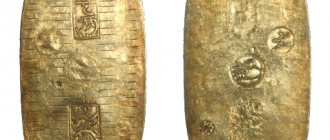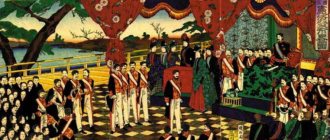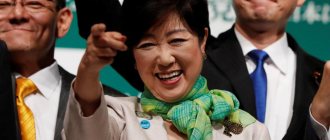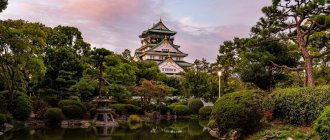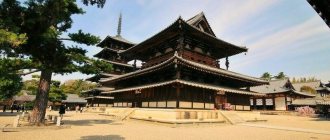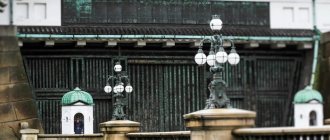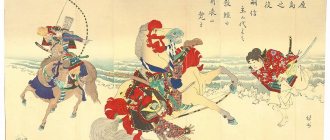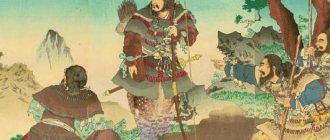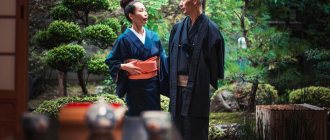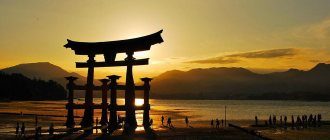On February 3, 1867, the 122nd ascended the throne of Japan. Emperor Mutsuhito, whose reign went down in history as the “era of reforms.”
Our country has a rather vague idea of Japan, both modern and ancient. It is mainly based on various cliches and cliches.
Today's Land of the Rising Sun is not at all similar to the state that experienced its revolution. Moreover, a special one, during which the monarch did not lose power, but, on the contrary, regained it.
For nearly 700 years of Japanese history, the emperor was a deified but essentially figurehead figure. The real ruler of the country was the shogun, which translated means “commander” or “commander”.
Article on the topic
Hirohito's hard day. How the Emperor of Japan became a man
A representative of the most influential Japanese clan became shogun. The title seii-taishogun was hereditary and clannish, although formally it was always complained by the emperor. There was no clear order of succession to the title: usually the shogun appointed a successor from among his sons, but if there were none, he adopted one of the representatives of other branches of the family.
the Tokugawa clan for 250 years . A special code was created for the emperor and his entourage, which ordered the monarch to devote his time to the study of science and the arts.
Emperors almost never left the grounds of Gosho Palace in Kyoto, except when the emperor relinquished power or, in the event of a fire, retreated to the temple's shelter. It was believed that the main duty of emperors was to perform rituals aimed at protecting the country from natural disasters.
Tokugawa Yoshinobu, Osaka, 1867. Photo: Commons.wikimedia.org
Imperial Revolution
The seemingly eternal order of things was called into question in the middle of the 19th century. Japan, like neighboring China, which lived in deliberate isolation, was faced with the Europeans' intention to force it to conclude trade agreements by force of arms.
Economically, socially and militarily backward, Japan could not resist external expansion. The shogun's government entered into treaties that threatened to place Japan in the position of a semi-colony.
Dissatisfaction with this state of affairs began to mature among the Japanese elite. The way out of the situation was seen as returning real power to the emperor.
Tokugawa Yoshinobu, the last shogun of the Tokugawa clan, as well as the last shogun in Japanese history, who took office in 1866, saw a way out of the crisis in government reforms in the European style. However, the shogun no longer had time to implement them. Under pressure from political opponents, on November 9, 1867, Tokugawa Yoshinobu officially announced the return of power to the emperor, who at that time was Mutsuhito . The emperor is known by this name only abroad: according to tradition, after death in Japan, the monarch is called the same as the era of his reign. Mutsuhito's era was called "Meiji", which means "era of reform".
Text of the book "Emperor Meiji and His Japan"
Alexander Nikolaevich Meshcheryakov Emperor Meiji and his Japan
Introduction one From the shadows into the light
The reign of Emperor Meiji (lived: 1852–1912, reigned: 1868–1912) was long.
So long that it now seems longer than the length of his human life. This impression is due to the fact that during the forty-five years of Meiji's reign, his Japan experienced truly dramatic changes. In the middle of the 19th century, it seemed to the West as an untenable outskirts of the “civilized” world in all respects. However, by the beginning of the twentieth century, Japan had become a powerful state, a full-fledged player on the world map. If earlier the Japanese talked about the threat coming from the West, then after Japan’s victories over China and Russia, the time has come to fear Japan itself. In just one generation, the country managed to create a modern industry and army. In just one generation, the old inferiority complex was transformed into a superiority complex. The people who lived on the archipelago did not call themselves Japanese before the Meiji reign. They identified themselves with their native village and principality. In just one generation, they recognized themselves as the Japanese nation. When Japan began to transform into a super-powerful economic power in the 60s of the twentieth century, people started talking about the “Japanese miracle.” But in fact, the “miracle” happened during the Meiji reign. The foundation of Japan's post-war successes was laid precisely under him. In accordance with a tradition that emphasizes the idea of succession, Meiji's name included a character taken from his father's name Komei (lit. "filial duty and light"; lived 1831–1866, reigned 1847–1866). This is the hieroglyph “mei” - “light”, “enlightened”. Thus, the name Meiji means "bright reign."
Despite the similarity of names, father and son existed in completely different dimensions. Komei lived his life in the “shadow”, he was hidden from human eyes by the walls of his palace in Kyoto, the military government (shogunate) in Edo (later Tokyo) forbade the emperor to leave the premises of the residence, and his “light” can only be perceived metaphorically. This is the “light” that emanated from the person of the emperor and shed only on his immediate and very small court circle. It and only it could observe the emperor, whose behavior was surrounded by the strictest prohibitions. It was impossible to even look at him; even sunlight was contraindicated for him - leaving the dim palace premises into the garden, the emperor was under the protection of a magical umbrella, which protected him from harmful fluids.
Meiji was born “in the era of shadow,” but he lived his adult life “in the light.” After he took the place of his father in 1867, his subjects were able to see him - on the streets and squares, at military parades and maneuvers, at train stations and exhibitions of the achievements of the Japanese national economy, in the theater, at the hippodrome, in the circus... And he also saw of his many subjects. He was the first of the Japanese emperors who was able to see with his own eyes that they really existed.
The metaphor of “light” and “shadow” is applicable not only in relation to the emperor, but also in relation to the country as a whole. From the Western point of view, all of Japan was also in the “shadow” until the middle of the 19th century: a minimum of contacts led to the fact that information about Japan was fragmentary and often did not correspond to reality. Europeans knew neither the centuries-old history of Japan nor its brilliant culture. Books about Japan were a real rarity. I. Goncharov likened Japan to a locked casket with a lost key.
The same can be said about the Japanese themselves: they were content with the information about Europe that a few Dutch merchants told them. These merchants from the East India Company were allowed to stop at Deshima Island near Nagasaki in the 17th century. But they had no right to leave him. In addition, information about foreign countries leaked through shipwrecked Japanese sailors. Apart from the Dutch, all other foreigners were prohibited from entering Japan; information about the West remained the property of a narrow group of people. These were “Rangakusha” - “Dutch scholars”. This was the name given to those people who were allowed to read European books.
For a long time, Japan was afraid of the outside world; it expected only troubles and dirty tricks from it. In the 16th–17th centuries, Europeans, most of whom were Catholic missionaries (mostly from the Jesuit order), brought firearms to Japan. In the minds of the Japanese, Christianity and guns became synonymous. The shoguns of the Tokugawa dynasty, who came to power at the beginning of the 17th century, considered it best to close the country. Both entry and exit were strictly prohibited. It so happened that Japan, surrounded on all sides by seas, stopped building large ships; it could be called a maritime country only with significant reservations.
The Meiji reign changed the situation dramatically: it brought with it a decisive expansion of communication, trade, and interaction with the world. Japan began to recognize the world, the world began to recognize Japan.
Coming out of the shadows was accompanied by dramatic consequences. Like a person who suddenly emerges from a dark cave into bright sunlight, Japan was temporarily disorientated, confused, and overcome by an inferiority complex. For some time, the inhabitants of the archipelago began to think that there was nothing worthy of praise in their country. But they did not sit idly by, but began to study. Science and technology, industry and culture, construction and management technologies, military affairs. Imitation for some time became the slogan of the day. However, the period of blind copying did not last long.
Traditional Japanese culture had enormous charm. Therefore, the West began to learn from Japan. European artists were fascinated by Japanese art. If you look at the matter from a macrocultural point of view, then the collision of Japan and the West was similar to the meeting of different temperature sea currents, when favorable conditions for the growth of “cultural biomass” are created in the contact zone.
One of the main consequences of Meiji rule was the birth of the Japanese nation. Without this, Japan would not be able to compete with the West. The Japanese nation was constructed in just a few decades under direct European influence. Until this time, there could be no talk of any “nation” - residents of different regions spoke dialects incomprehensible to each other, each person believed that he belonged to his village, city, principality, clan. Why did he need to feel like a “Japanese” if the country voluntarily broke all ties with the world? However, it turned out that in the 19th century the sea could no longer be kept locked. Once Europeans “discovered” Japan, the question became possible: “How are we different from the uninvited strangers?”
The formation of a nation is closely connected with the figure of Meiji. For it became the symbolic center around which the Japanese were “glued together” into a single whole. Therefore, the fate of Meiji and the fate of the Japanese people cannot be considered separately. Having the status of a “living god,” Meiji still remained one of millions of Japanese. After all, he was their symbol.
The main task of this book is to show how the transition of Emperor Meiji and all of Japan “from shadow to light” took place. I wanted to trace how the inhabitants of the archipelago began to feel like Japanese, how their ideas about power and themselves changed, through what tools the unity of state and society was achieved, how the culture that we now call Japanese was born. This task is huge and “panoramic”, and, naturally, I did not have the opportunity for a full-length story about all the events and problems.
In this regard, the selection of information that I offer the reader is not entirely ordinary. Of course, I could not ignore the “deep” problems - social, political, economic. But many of them are well studied and can be read about in other books. That's why I don't always talk about them in detail. At the same time, much less attention was paid to the “external” side of the history of this time. However, this is not entirely “fair” to the witnesses, creators and participants of the events. The colossal attention that they themselves paid to the “external” side of life - clothing, food, rituals, ceremonies, customs, holidays, processions, parades, etc. - speaks in favor of the fact that this side of life also needs to be described and comprehension. The overwhelming majority of contemporaries of the events did not think in scientific categories - social formation or political system. Their primary organ of perception was their eyes. Therefore, I wanted - as far as possible - to look at Meiji Japan through the eyes of contemporaries, to find out how their vision was structured, to show what events and phenomena worried them most. In connection with all this, I tried to introduce into the book as much material as possible that would be as “pictorial” as possible.
When writing this book, I abandoned the “problematic” style of presentation, when the author alternately examines politics, economics, culture, etc. For me, something else was more important: to show how the accumulation of events, experience, time, and history took place. Therefore, I tried to make sure that the structure of the text corresponds to the structure of real time. I wanted to show how Japan was changing. It changed quickly, but this rapidity had its own gradualness. Graduality, without which there is no history. In this regard, I chose the “chronicle” method of narration: each chapter tells about one year in the life of Emperor Meiji and about one year in the life of his country. As in the “real” chronicle, the fullness of a given year with events is uneven. Medieval Japanese aristocrats believed that a year lived slowly seemed long. However, what is true for private life is not always true for the country. In retrospect, a year in which more turbulent events took place - reforms, crimes, wars - seems longer.
Applying to the tasks at hand, I divided the book into two parts. The first tells about the time of the “shadow”, when the future Emperor Meiji was a child, when the acquaintance of the Japanese and Europeans was just beginning. Japan stood on the threshold of great changes, about which the future emperor still knew nothing. This part is more of an introductory nature, its task is to show what Japan was like under the Tokugawa shogunate, what problems the authorities had to solve when Europeans began to increasingly insistently demand that Japan “open up” to the world. The second part tells about the formation of a new Japan. It was a dramatic and controversial process, accompanied by the loss of old Japan.
The reader may find some of my assessments regarding the participants and creators of the historical situation too harsh and even cruel. I did not revel in my own impunity and did not want to offend anyone. It’s just that, compared to the creators of events, the historian is in a more advantageous position: he knows what happened next. And “then” many tragic events occurred, including World War II. It is my deep conviction that many of the people discussed in the book were indirect accomplices of these events.
However, this advantage of the historian is very short-lived. By the time the reader reads this book, new facts will be discovered and many events will occur that the author does not yet know about. They will no longer be able to change the text I wrote, but they will certainly provide food for new thoughts. History continues regardless of the verdicts that the historian makes on it. History is a process, and a book is the result. No one has yet managed to overcome this contradiction.
When working on the book, I had to use many sources and research. Links to them are given in the main text. The bibliography devoted to the Meiji period is enormous and impossible to count. It was not my task or strength to do this and consider all existing theories, concepts, views. I will express only one consideration of the most general nature. All the works I know were written by specialists who have been studying this period all their lives. This is their advantage, which, as always happens, smoothly turns into a disadvantage. The main subject of my studies has always been ancient history, and therefore I do not dare to claim a more detailed - in comparison with many experts I respect - knowledge of the realities of the Meiji period. However, knowledge of the realities of antiquity made it possible, as I hope, to give the understanding of the Meiji time a somewhat greater volume. The starting point for my reflections were the conclusions drawn in my monograph dedicated to the institution of supreme power in ancient times [1] 1
Meshcheryakov A. N.
The Japanese Emperor and the Russian Tsar. Element base. M.: Natalis; Ripol classic, 2004.
[Close].
Fairness requires mentioning several pioneer books that turned out to be especially useful to me. All of them acted as a kind of intellectual “catalyst” that prompted me to finally begin to implement the plan I had for a long time. I have long had the intention of looking at the events of modern history through the eyes of an expert in antiquity. However, busyness and inertia did not allow me to find time for this. It happened, however, that almost simultaneously I came across three books at once, which finally filled my “cup of patience” and forced me to sit down to master new material for me.
This is Taki Koji's book "Emperor Portraits", which traces how the first Meiji images were created and what role they played in the formation of the culture of the "people's state"[2] 2
Taki Koji.
Tenno no shozo. Tokyo: Iwanami, 2002.
[Close]. This is the book by Fujitani Takashi “The Splendid Monarchy” [3] 3
Fujitani T.
Splendid Monarchy.
Berkeley; Los Angeles: University of California Press, 1996. For partial translation, see Takashi Fujitani.
Magnificent monarchy // New Literary Review. 2002. No. 4. pp. 67–95.
[Close], dedicated to the rituals and ceremonies of the Meiji period. Fujitani managed to introduce Japan into an international “ceremonial” context, which does not always happen with Japanese scholars. This is, finally, an extremely informative volume, “The Japanese Emperor. Meiji and His World,” written by Donald Keene[4] 4
Keene D.
Emperor of Japan. Meiji and His World, 1852–1912. New York: Columbia University Press, 2002.
[Close]. Based on the official chronicle “Chronicle of Emperor Meiji” (“Meiji Tenno ki”), D. Kin did a great job of introducing into circulation data that allows us to at least to some extent judge the human qualities of the emperor.
In conclusion, I would also like to express my sincere gratitude to Numano Mitsuyoshi (University of Tokyo), K. G. Vinogradov (ISAA at Moscow State University), A. M. Gorbylev (ISAA at Moscow State University), I. V. Melnikova (Doshisha University, Kyoto), E B. Sakharova (Russian State University for the Humanities), A. I. Yusupova (Moscow Kremlin Museums) for valuable advice and selfless assistance in collecting materials used in writing this book.
Introduction Two Setting: Edo and Kyoto
The main events of this book take place in two cities - Kyoto and Edo (Tokyo). Therefore, before starting the main story, I decided to introduce the reader to these cities. Getting to know the place of action will allow you to better understand the time in which the events of the Meiji reign were layered.
The Japanese Emperor lived in Kyoto. The city was founded back in 794. Then it was called Heian (“capital of peace and tranquility”). But by the end of the 12th century it began to be called simply Kyoto (“capital city”). It retained this name in the 19th century.
The builders of Heian believed that the capital of the Tang Empire, Chang'an, served as a model for the city. The similarities between the Japanese and Chinese capitals are visible in the following: the rectangular plan (5.3 km from north to south and 4.5 km from east to west), the location of the imperial palace in the north, the wide (85 m) Suzaku Avenue, which divided the city into two symmetrical parts (western and eastern), intersection of streets and alleys at right angles.
However, there were significant differences between Heian and Chang'an. The area of Heian was only about a third of the territory of the Chinese capital. Chang'an was surrounded by five-meter walls that protected it from nomads, but Heian was not surrounded by such walls. Only near the Rashomon Gate in the south of the city did a wall only two meters high “rise” - it served only as a symbolic cover for the capital. This wall fell into disrepair by the beginning of the 10th century. Fortunately for Japan, there were no formidable nomads in the country. The population of Chang'an was more than one million people, the number of inhabitants of Heian was about 150 thousand. The population of Kyoto increased to one million only in the 20s of the twentieth century. In the 18th – early 19th centuries, its population was about 500 thousand people.
The previous Japanese capital, Nara (710–784), was built according to the same principles as Heian. Therefore, in the most general terms, Heian may be more reminiscent of Nara than Chang'an. The population was also comparable - from 100 to 200 thousand people lived in Nara. But the political elite preferred that Heian be compared with the Chinese capital - after all, China was considered at that time the trendsetter of Far Eastern fashions.
The most impressive architectural project of Heian was, of course, the imperial palace. It was a rectangle measuring 1.4 by 1.2 km. Inside the palace there were two main complexes: the “inner palace” (dairi), where the emperor himself lived, and the “large inner palace” (daidairi), where the main governing bodies of the country were located.
Of course, not all of Heian's urban space was an urban landscape. About half of the city's territory was occupied by wastelands and peasant fields. Nevertheless, Heian remained the largest city in Japan for a long time.
The great novel “Genji-monogatari” (“The Tale of Prince Genji”, early 11th century) by court lady Murasaki Shikibu introduced the term “hana no miyako” - “capital of flowers”.
They bloom and immediately fall, The earth is covered with flowers of the passing spring. Are you leaving? You too will return to the capital of flowers.
At that time, “flowers” meant sakura. There were many cherry trees in Heian. Of course, there were enough of them in other cities and villages. But it was among the courtiers of Heian, free from daily worries about their own food, that the likening of human life to the transience of cherry blossoms took root.
This approach has brought many aesthetic and existential discoveries, but it is unlikely that the state organism can rest on such foundations; it requires symbols made of more durable material. It is not surprising that the brilliant cultural life of Heian was accompanied by a crisis of the entire socio-political system. This is not surprising, because to the residents of the capital the rest of the country seemed like a remote province, a stay in which was unworthy of a refined person. Appointment even to such a high position as governor was perceived almost as a punishment. By European standards, the wealth gap between rich and poor in Japan did not look too provocative, but the difference in social status and “culture” was enormous. And the Heian aristocrats did not allow any strangers into their closed world.
Map of the Japanese archipelago. XIX century
Femininity became the ideal of aristocrats - the outfits of court men resembled those of women, men plucked their eyebrows, powdered their faces, and blackened their teeth. They took part in endless ceremonies, wrote poetry, played music and indulged in lovemaking. Sensuality and sensitivity have become signs of an “elegant” life. The main part of the life of aristocrats took place in interiors; courtiers rarely left the confines of the tiny space in which they lived. It is not surprising that they replaced wild nature with gardens - it was there that they watched one season give way to another. The roads were overgrown with grass, the emperor's decrees were not carried out. The capital's aristocrats did not have sufficient energy to collect taxes and properly maintain the infrastructure of the country as a whole.
The emperors themselves could serve as a model in the mastery of verse and brush; they regularly performed the rituals due to the rulers of an agricultural country, but they were infinitely far from the thought of leaving the palace and watching rice grow. The aristocrat's vision became “myopic” - he saw what was happening under his nose, but he was not at all interested in the lives of people who did not belong to his circle.
The Heian aristocrats did not notice the “rabble” and, of course, were unable to ensure the unity of the country, which split into many principalities. Each of them had its own squad of samurai. The capital's aristocrats continued to be regularly appointed to the posts of advisers to the emperor and ministers, but now these positions turned into fiction.
Continuous strife from time to time led to the emergence of a victorious house in the country, which for some time was able to maintain relative order. And then its head received the title of shogun (general) from the emperor and created his own government. First it was the house of Minamoto, who settled in Kamakura (1185–1333), then Ashikaga, who preferred the Kyoto area called Muromachi (1392–1573). In 1603, power fell into the hands of the Tokugawa shoguns. They did not set as their goal the overthrow of the imperial house - the idea that the imperial dynasty was irremovable was too firmly rooted in their consciousness. The shoguns did not dare to encroach on the authority of the dynasty; there were no candidates for the role of usurper, but the military deprived Kyoto of any administrative powers.
The founder of the Tokugawa shogunate, Ieyasu (1542–1618), located his headquarters in Edo, 500 kilometers from Kyoto. It was in Edo that the castle of the shoguns was located, where the institutions that governed the country were located. The emperor and his aristocrats were deprived of the right to vote in decision-making, he was “guarded” (and at the same time watched over) by the shogun’s soldiers, but Kyoto for a long time retained the glory of the most “stylish” city in the country.
Missionary Joao Rodriguez (1558–1633) described his impressions of Kyoto as follows: “Residents of Miyako (the capital - A.
M.) have gentle morals, they are extremely well mannered and love entertainment. They dress beautifully, love to have an interesting time, and constantly indulge in entertainment, fun and relaxation. For example, they arrange feasts in nature, enjoy flowers and gardens, and unite in amusements; they watch comedies and dramas, with kyogen farces shown in between. They love trendy songs. They are very pious and often visit temples... Their speech is the most magnificent and refined in the whole country, since the common people here speak the language of the court and aristocrats.” Half a century later, the German E. Kaempfer (1651–1716), who came to Japan as a ship’s doctor on a Dutch ship, agreed with him: “Kyoto is known throughout the country for its crafts. If something, even if it is known to be of poor quality, is made in Kyoto, it will have an advantage over others.”
The artisans of Kyoto acted as trendsetters. The fabrics and clothes they made, ceramics and fans, sweets and sake were considered the best gifts in any society. With the establishment of the Tokugawa shogunate, peace came to the country, and the city began to grow rapidly. At the beginning of the 17th century, its population barely exceeded 200 thousand people; by the end of the century it had grown to half a million.
But Edo grew even faster. Along with the trading city of Osaka, which was considered the “cuisine of Japan,” the most energetic people of the era were concentrated there. Edo began to be called “Toto” - “eastern capital”. Kyoto was sometimes referred to as "Saikyo" - "western capital". The proud samurai of Edo began to question Kyoto's charm. The famous satirist Shikitei Samba (1776–1822) wrote: “Although two hundred years ago Kyoto was considered the “flower capital,” the city has now become a suburb, becoming a “flower village.” Another writer and essayist, Matsue Shigeyori, echoed him: “The sake that is made in Kyoto is like water. No matter how much you drink, it doesn’t take away.”
Previously, when Kyoto was unambiguously associated with the best of everything, such derogatory assessments were unthinkable. People began to say that the people of Kyoto wore clothes of outdated styles, that their former politeness had given way to rudeness and bad manners. Kanzawa Toko, who served for many years as a policeman in Kyoto, wrote in 1791: “The goods made in Kyoto for sale are bad. Tofu (bean curd. – A. M
.), which was previously considered the best, is now inferior to Osaka tofu - very tender and soft. If you ask anything in Kyoto, people answer without pleasure, if at all. There are no such indifferent people in the country as in Kyoto. In the past, Kyoto residents at least tried to pretend to be polite, but that is no longer the case.” Kanzawa was also indignant at the passivity of the inhabitants of Kyoto. He noted that after the fires, Osaka was being rebuilt much faster than the capital.
The glory of Kyoto as the “boutique of Japan” has been fading since the end of the 18th century; samurai from Edo begin to believe that they are the ones living in the best city in the country. Guidebooks, instead of Kyoto goods, prefer to advertise local historical monuments: Buddhist temples, Shinto shrines and the imperial palace, closed to the public, near which one could breathe the air of the past. From the much-admired capital, Kyoto is turning into something like an open-air museum. But still, Kyoto had something that Edo could not have: an emperor and a thousand-year history.
The Zen monk and famous poet Ryokan (1758–1831) wrote:
Thousands, thousands of years of reign of sovereigns... Where can you find the words to say About the capital in bloom?
For centuries it was believed that the main responsibility of the emperor and his court was to perform rituals. Such rituals served a dual function. Firstly, they were called upon to protect the entire country from disasters (droughts, rainstorms, typhoons, earthquakes, fires) and ensure the well-being of their subjects. At the same time, no participation of the “people” in the ritual was assumed: the more secret the ritual was, the more effective power it had. These rituals gave meaning to the very existence of the court, knowledge of their smallest details served as a sign of belonging to a very special social group. In other words, ritual was a means of self-identification for courtiers, the glue that ensured the unity of the ancient aristocracy.
In the eyes of the shogun and his entourage, the imperial court had unconditional “ritual authority.” Neo-Confucianism formed the basis of the official ideology of the shogunate. The Tokugawa had no opportunity to ignore its most important postulates: the primacy of secular-spiritual power over military power, the paramount importance of ceremonial activity. For only rituals and ceremonies ensure order in the Celestial Empire and separate a cultured person from a barbarian. In the first article of the “Institutions for the Emperor and Courtiers” (1615), the shogunate ordered the emperor to study Chinese “sciences” (meaning classical education of the Confucian type) and Japanese poetry. It is often said that this situation indicates the powerless position of the imperial court. But this is only partly true. Preserving the ritual in working order served in the eyes of the shogunate as the most important condition for the well-being of the state. In the conditions of endless wars of the past era, the imperial court became impoverished, many ceremonies were no longer organized and the rules for their conduct were lost, and this was perceived as a loss of harmony and the onset of chaos.
The court itself clearly realized that it was in ritual activity that the secret of restoring lost positions lay. In this regard, the emperors were collecting information on the ancient ritual and studying it. From the reign of Gomizunoo (1611–1629) to the reign of Gomomozono (1771–1779), emperors compiled 17 works on ceremony and ritual. An amazing fact: at the Bodaiji Buddhist Temple in Edo, where memorial services were held for members of the shogunal family, the abbot was the prince of the blood, whose birthplace was Kyoto. On the one hand, he was a hostage of the shogun, but on the other, the position was not entrusted to anyone else. The situation was such that the shogun and the emperor could not exist without each other. The shoguns fed the emperor, and he provided them with “ritual cover.”
Of course, the activities of the shogunate in Edo were also surrounded by certain rituals, but the Kyoto aristocrats considered the samurai ceremonies “barbaric.” The courtier Nonomiya Sadamoto, who was ordered to attend the memorial service for the Tokugawa Ietsuna shogun in 1696, wrote in his diary that the military did not know proper manners, and therefore there was no point in recording what happened in Edo. Therefore, for more than one month, which he spent surrounded by samurai, he did not make a single entry in his diary.
The shogunate provided the Kyoto court with funds for ritual activities. However, the regular provision of the emperor was very insignificant. Therefore, the court from time to time submitted petitions for a one-time allocation of funds for the implementation of certain ritual projects. The shogunate responded to them quite often. In this sense, the Tokugawa shogunate took a much more balanced and softer position towards the court compared to the previous Ashikaga shogunate. During the Tokugawa period, many rituals lost under Ashikaga were restored at the emperor's court: the full form of enthronement, the crown prince initiation ceremony, festivities in some shrines, horse-drawn archery (yabusame), the winter solstice festival, etc. The emperor and courtiers possessed secret knowledge rituals that no one has been able to repeat. And the shogun was no exception here.
Although the well-being of the imperial court depended entirely on the shogunate, one cannot leave the feeling that somewhere in the depths of their souls the shoguns and their inner circle understood: their power was “incomplete” and rested on shaky foundations. The authority of the emperor was so great that even Ieyasu, the founder of the Tokugawa shogunate, considered it best to falsify his pedigree, tracing his descent to Emperor Seiwa (858–876). Even at the time of their greatest power, the Tokugawa experienced problems with legitimacy. Japanese society was governed by a "genealogical code." The principle of heredity of occupations was the main one in all spheres - from the elite to peasants, artisans, and merchants. At the imperial court itself, opportunities for social mobility were still reduced to a minimum, and the main positions at the court were occupied by the descendants of aristocrats of only five families (“gosekke” - Konoe, Kujo, Nijo, Ichijo, Takatsukasa), known since the Heian-Kamakura period.
The shogun lived in his castle in Edo, built in the early 17th century. The walls of the Cyclopean masonry were surrounded by a wide moat with water. Kyoto was intended for peaceful life; there were no defensive structures. The purpose of Edo was defense against possible attacks from rebellious principalities. The ditch was wide, but the streets were narrow to make it difficult for the cavalry of a potential enemy to advance. The paradox is that during the Tokugawa era, a potential enemy never turned into a real enemy.
Japanese Civil War
Tokugawa Yoshinobu hoped that the formal abolition of the shogunate would allow him to simultaneously maintain his clan in power. However, political rivals turned out to be stronger. The new government was formed by opponents of the shogunate. On behalf of the emperor, it adopted a decree abolishing the shogunate and restoring direct imperial rule. The new government stripped the ex-shogun of all his titles and most of his landholdings. In response, Yoshinobu moved from Kyoto to Osaka Castle, where he began preparations to overthrow the opposition and return to power.
Troops of the Tokugawa shogunate (1864). Photo: Commons.wikimedia.org
As often happens in history, a revolutionary change of power was followed by a civil war, known in Japanese history as the Boshin War.
The armed conflict, which began in January 1868, ended in May 1869 with the complete defeat of the supporters of the shogunate.
It must be said that the Boshin War was quite moderate in terms of the number of casualties. The conflict, which involved approximately 120,000 people on both sides, resulted in approximately 4,000 deaths.
For the last shogun, this defeat only resulted in house arrest, from which he was released after a relatively short period of time. Tokugawa Yoshinobu was restored to a number of privileges, and in 1902 he was granted the title of duke, included in the new Japanese kazoku aristocracy and given a seat in the House of Peers of the Imperial Diet of Japan. However, the shogun, who lost power, moved away from politics, devoting his life to photography, hunting and the game of Go.
The young Emperor Meiji with foreign representatives at the end of the war. Photo: Commons.wikimedia.org
"Five Point Oath"
Even before the victory in the Boshin War, Emperor Mutsuhito proclaimed the program of his reign in the form of the so-called “Five Point Oath”:
1. We will convene meetings and govern the people, taking into account public opinion.
2. People of higher and lower classes, without distinction, will be unanimous in all undertakings.
3. Civil and military officers will be treated in such a way that they will be able to perform their duties without dissatisfaction.
4. Outdated methods and customs will be destroyed, and the nation will follow the great Path of Heaven and Earth.
5. Knowledge will be borrowed from all nations of the world, and the Empire will reach its highest point of prosperity.
Mutsuhito's behavior was also revolutionary. He left the imperial palace to personally lead the troops fighting the supporters of the shogunate. Mutsuhito became the first emperor in many centuries whom the Japanese could observe closely: he traveled around the country to familiarize himself with the state of affairs on the ground.
The sixteen-year-old emperor moving from Kyoto to Tokyo (1868). Photo: Commons.wikimedia.org
In September 1868, Mutsuhito renamed the city of Edo Tokyo. The formal coronation of the emperor took place on October 15, 1868. It was then that the monarch proclaimed the beginning of the Meiji era.
Japan was faced with an extremely difficult task: to quickly rebuild the state so that it could be competitive.
Article on the topic
The power of PR: how one man defeated Japan and the USA
Government structure
During the civil resistance, the imperial government established its own political standards. In February 1868, the government declared its legitimacy to representatives of foreign countries. Accordingly, the emperor acted as the head of the country. He had the right to carry out foreign policy activities and establish diplomatic relations. In early April, the Five Points Oath was issued. It set out the basic principles by which the Meiji Restoration in Japan was to take place. These Five Points provided:
- Collegiality of the board.
- Participation in the development of decisions by representatives of all classes.
- Refusal of xenophobia.
- Compliance with international legal standards.
- Opening the state to the world in order to obtain the knowledge necessary to strengthen governance.
In June 1868, a new government structure was approved by decree on state structure. It became known as the Chamber of the Great State Council. From the Constitution of the United States, the government borrowed the principle of a formal division of power into representative, judicial and executive branches. Officials were required to be re-elected to their positions every 4 years. Senior services were approved in the structure of the central apparatus. They carried out the tasks of the ministries. Junior services were formed in the regions, representing the central government in administrative-territorial units. After Edo was captured and renamed Tokyo, a new Meiji motto was adopted in October. Japan received a new capital.
New order
The government of the state was taken over by the State Council, composed of ministers. By 1885, the structure of the government was as close as possible to the European one, and the post of prime minister was introduced. The emperor took part in meetings of the cabinet of ministers, but spoke very rarely himself.
The system under which local government was concentrated in the hands of daimyos, sovereign princes, was abolished. Some daimyo transferred their possessions to the emperor voluntarily, while others had their lands taken away.
In 1871, by decree of the emperor, the autonomous regions were abolished, and the country was divided into 72 prefectures. The daimyo received high monetary rewards and were required to move to the new capital, Tokyo. Many of them left political posts.
In 1868, the abolition of workshops and guilds was proclaimed and the right to freely choose a profession was granted to everyone. The entire Japanese population received the right to free movement throughout the country. Formal equality of all classes before the law was introduced and the right of private ownership of land was established, a unified land tax was established, replacing numerous feudal taxes.
Young Emperor Meiji in military uniform (1873). Photo: Commons.wikimedia.org
A parliament was created in the country, but it did not have real power: at the beginning of this period, Japan remained an absolute, not a constitutional monarchy.
The Japanese army began to rebuild at an accelerated pace according to European canons. This happened during the “Boshin War”, and after its end the process acquired an even larger scale.
After the liquidation of the principalities, their troops, consisting of samurai, were reassigned to the Ministry of War. In 1873, the government introduced universal conscription in the country. From now on, all men who reached the age of twenty were required to serve in the army, regardless of their social origin.
Simultaneously with the military reform, police units separate from the army were created.
Administrative reform
To form a unitary Japan, the elimination of the federalist structure was necessary. During the civil war, the government confiscated the shogunate's properties, which were divided into prefectures. But the territories of the principalities remained outside control. On January 20, 1869, four pro-government daimyos submitted a petition declaring that everything belonged to the Emperor. In February 1869, officials proposed to the Emperor to subordinate their territories to the government. The daimyos from Satsuma, Tosa, Choshu and Hizen agreed to the proposal, returning the lands to the monarch along with the population. In July 1868, the government ordered the other daimyo to do the same, which was carried out without resistance. Only twelve princes did not voluntarily hand over the land registers, but later they obeyed the order.
Are you an expert in this subject area? We invite you to become the author of the Directory Working Conditions
In exchange for lands, princes became heads of central government offices in the regions and received a salary. Although the lands were transferred to the state, the khans themselves were not abolished. Daimyo retained the right to collect taxes and form troops on entrusted lands, thus remaining semi-autonomous. This half-hearted policy caused discontent in the regions. On August 29, 1871, the government proclaimed the establishment of prefectures instead of khans. The daimyo were moved to Tokyo, and dependent governors were appointed in their places. By 1888, the number of prefectures was reduced from 306 to 47, Hokkaido was allocated a special district, and the cities of Tokyo, Kyoto and Osaka were equated to prefectures.
The Emperor experienced the first railway in Japan
In 1876, the Japanese government decided to begin the practice of calculating pensions for nobles. Up to a third of the state budget was spent on state support for this class. The nobles left without funds were forced to switch to government service or engage in entrepreneurship.
Article on the topic
Sex slaves for the emperor's soldiers. How Japan is paying for old sins Large-scale land and tax reforms were carried out. In 1872, the ban on the sale of land was lifted and the existence of private property was recognized. Instead of the previously existing quitrent in kind, the state began to receive a cash tax from landowners in the amount of 3% of the value of the land plot.
In 1871, the Ministry of Culture was created, the central institution responsible for educational policy. In 1872, it decreed a public education system based on the French model. However, the authorities soon came to the conclusion that creating an education system modeled on France was too difficult, and in 1879 a decree “On Education” was issued, according to which compulsory public education was limited only to a German-style elementary school. For the first time, state educational institutions appeared where boys and girls studied together.
Kaichi School is the oldest elementary school in Japan. Photo: Commons.wikimedia.org
In 1877, the University of Tokyo was founded, and pedagogical institutes and higher education institutions for women were actively created in the prefectures.
With the help of Europeans and Americans, a large-scale project to industrialize the country began to be implemented. In 1872, under the direction of European engineers, the first railway was opened, connecting Tokyo with Yokohama. The locomotives were brought from Europe, and the station building was designed in the USA. The first passenger was the emperor himself.
In 1877 and 1881, industrial exhibitions were held in the country to introduce promising global technologies in industry and agriculture. In 1877, Alexander Bell established a telephone line between Tokyo and Yokohama.
Article on the topic
Russian Apostle of Japan. How Father Nikolai converted the Japanese to Orthodoxy
The wooden buildings traditional in Japan were replaced by solid stone houses.
Social reforms
The imperial government pursued an active social policy. On June 25, 1869, two privileged classes were formed - titled and untitled nobility. The first included the capital's aristocrats and former daimyos, the second included the middle and small samurai. In this way, the government tried to overcome the confrontation between samurai and aristocrats and eliminate the medieval “master-servant” model.
The imperial government also announced the equality of peasants, artisans and merchants, regardless of occupation and position. In 1871, the government classified them as pariahs who had been discriminated against during the Edo period. The common people were allowed to have surnames, which previously were exclusively among samurai, and the nobility were allowed inter-class marriages. Restrictions on travel and changing professions have been lifted.
The nobility was completely supported by the state. It received an annual pension amounting to 30% of the country's budget. To ease this financial burden, in 1873 the government published the “Law for the Return of Pensions to the Emperor,” obliging the nobles to refuse to receive pensions in exchange for one-time bonuses. But the problem was not solved, and the debt for pension payments was growing, so the authorities in 1876 finally canceled their accrual and payments. The legal difference between samurai and common people disappeared. To ensure their existence, part of the privileged class became employees: clerks, police officers or teachers. Many took up farming. Those who went into commerce quickly went bankrupt due to lack of skills. To save samurai, the government provided subsidies and encouraged the development of semi-wild Hokkaido.
Note 2
But these measures were not enough, which in the future became the cause of unrest.
Constitution of the Empire
Industrial enterprises were founded like mushrooms after rain. In the recently closed Japan, fashion for European clothing and a European lifestyle appeared. True, many believed that this was damaging to traditional values, and such fears were not unfounded.
In 1872, Japan switched to the Gregorian calendar, and newspapers and magazines began to be published in the capital. Foreign delegations were received in Tokyo, and a special ceremony was developed for the meetings of guests with the emperor, which, while emphasizing the importance of the figure of the monarch, should at the same time not affect the dignity of foreigners.
The Emperor of Japan receives the French military delegation at the Kyoto Imperial Palace. Photo: Commons.wikimedia.org
In the international arena, Japan sought to revise enslaving trade agreements and create an equal partnership.
In 1889, the Constitution of the Empire of Japan was introduced. In addition to defining the fundamentals of the legal status of the emperor and executive authorities, it established a list of fundamental rights and freedoms of Japanese subjects, introduced into the system of government bodies a parliament with legislative power, the lower house of which was elected by the population, and also established an independent court. The Constitution came into force in 1890.
Emperor Meiji in 1890. Photo: Commons.wikimedia.org
Changes in government
The executive branch was based on the 8th century government structure. As a result of the Meiji reform, the government was divided into three chambers: right, left and main. The latter played the role of the cabinet of ministers. It included state, right and left ministers, as well as advisers. The left chamber acted as a legislative body. The right branch included 8 ministries, the leadership of which was carried out by ministers and deputies. Most of the government positions were filled by people from pre-existing principalities. They formed "khan factions". The main positions belonged to the capital's aristocrats.
The Great Break
The Meiji era was a turning point for Japan. Over the course of a couple of decades, the country transformed from a backward feudal state into an advanced capitalist power that began to challenge its neighbors. Not everyone was ready for this: for Russia, defeat in the Russo-Japanese War of 1904-1905 was a bitter revelation.
The ambitions of the Japanese elite began to grow by leaps and bounds. The downside of the progress of the Meiji era was plans for large-scale colonial expansion and the growth of Japanese militarism. These processes will reach their peak during the Second World War.
This, however, no longer applies to the story of Mutsuhito, the 122nd Emperor of Japan, who left this world before the outbreak of World War I: July 30, 1912.
The New York Times, describing the farewell ceremony for the emperor, wrote this: “The contrast between what walked in front of the funeral wagon and what walked behind it was truly striking. Old Japan came before her, new Japan followed her.”
Meaning
As a result of the restoration, Japan “jumped” into modern times. The army was reorganized. The construction of a full-fledged military fleet has begun. Government reform, social and economic reforms, as well as the rejection of self-isolation have created favorable conditions for the development of Japan into a competitive, including economic, society.
On the one hand, Japan avoided the risk of becoming completely politically dependent on European powers or the United States. (The closest European power to Japan was and is Russia. True, Russia did not pursue a policy similar to English colonialism, preferring to extract benefits in other ways.) On the other hand, having joined the economic and political race with Europe, Japan has gone far ahead in comparison with other eastern countries. -Asian states.
Source: Wikipedia
